Square Vs Rectangle Trampoline – Which Is Better?
Whenever I move house, I make sure my new place has a large backyard. Me – being a trampoline fanatic since childhood – want enough space to install a new trampoline anytime I move to a new place.
And very recently, I was blessed with a nice backyard that can support a bigger trampoline that my whole family can enjoy.
Until now, I have mostly used round trampolines, but this time I decided to switch things up. My choice was between a square trampoline and a rectangular one. Since I had never used one of these two shapes before, I had a lot of catching up to do.
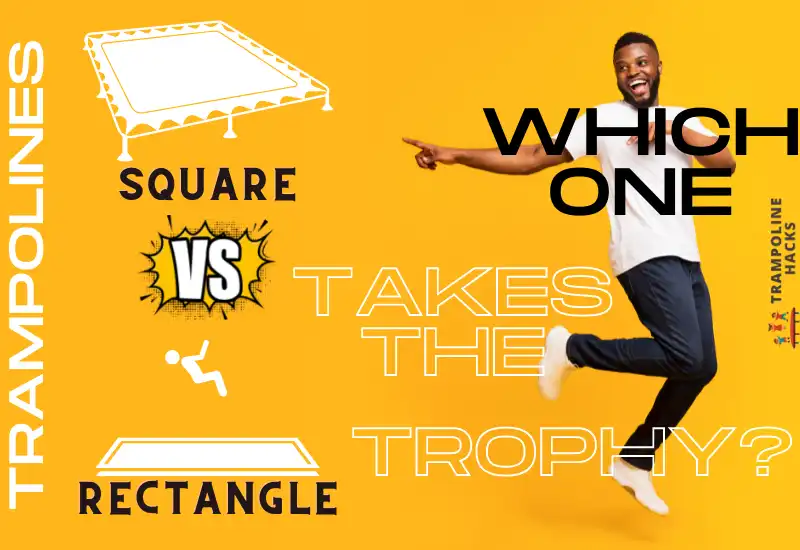
It turns out there are some major differences between the two shapes in how high they bounce, how much they cost, and even how safe they are. And if you are in a similar situation, what I learned then could help you out now.
Check Square vs rectangle trampoline
So, I’ve decided to give you a quick yet thorough rundown of the differences between a square and a rectangle trampoline and help you pick out the perfect one for your needs.
Spoiler Alert: I ended up going with a rectangular trampoline.
An Easy-to-Follow Breakdown of Square Vs. Rectangular Trampoline
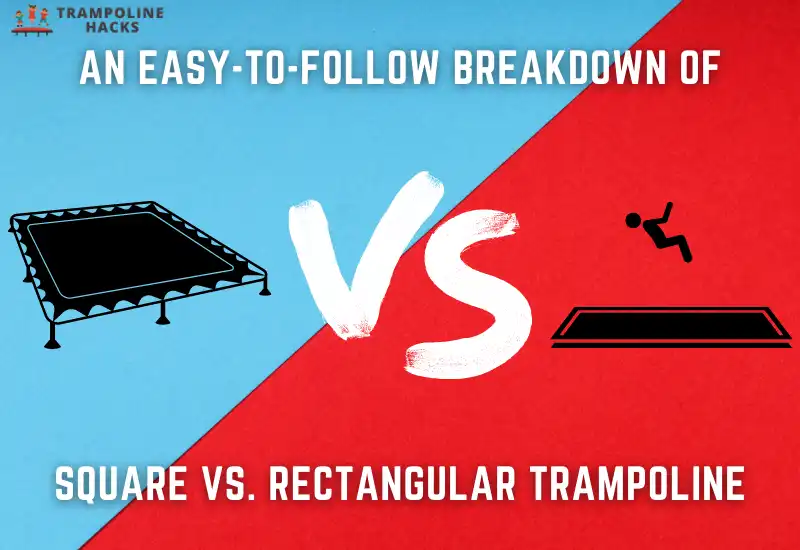
The chart here isn’t as comprehensive as the explanation below. There are no specific metrics to categorize both trampolines. And with so many variables to account for – it’s difficult to narrow it down. The chart here should give you a rough idea of what to expect from a square and rectangle trampoline. However, if you really want to get into the good stuff, read the details outlined below.
Check Upper bounce vs skywalker
| Features | Square Trampoline | Rectangular Trampoline |
| Frame Strength | Strong | Strong |
| Bounciness | Comparatively weak | Better |
| Jumping Area | Small | Larger |
| Weight Capacity | Suitable for One or Two People | Suitable for Three or More People |
| Safety | Safer (less space) | A Bit Risky (large space) |
| Price | Cheaper | More Expensive |
| Usage | Casual | Semi-professional/ Enthusiast-grade |
How Do I Pick Between Square and Rectangle Trampoline?
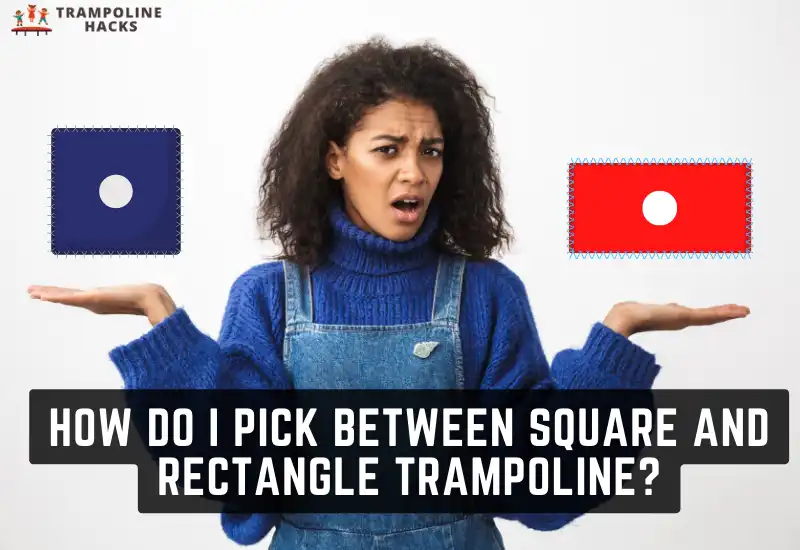
Personally, I do not put too much thought into the size of the trampoline. As long as it fits in my backyard and is safe for the kids, I am happy. But many homeowners want to make sure their money is not going to waste and look at every little bit of detail when buying a new trampoline.
I completely understand this thought process since a square or a rectangle trampoline can be quite expensive. In fact, if we are talking about price, both of these shapes are pricier than a round trampoline. And naturally, you want to make sure you are getting a trampoline that gives you good value for your money.
That being said, here are a couple of things that you want to know about when you are deciding between a square and a rectangular trampoline.
Check In Ground vs Above Ground trampoline
FYI: If you’re interested in round trampolines, the round vs. rectangular trampoline comparison can give you some pointers.
1. Frame Strength
The first thing that I like to check when I am going for a new trampoline is the quality of the frame. If the frame does not feel sturdy and does not dig into the ground properly, then I try to avoid it. Cheaper trampolines typically have poorly designed frames that cause a lot of the trampoline-related accidents that you hear about each year.
However, the shape of the trampoline rarely has anything to do with the quality of the frame. You can find a strong and sturdy frame in both square and rectangular trampolines. It mostly depends on the quality of the trampoline that you are buying. Still, I believe it is worth mentioning here to make sure you are putting your eggs in the right basket.
2. Bounciness
Since both square and rectangular trampolines are pretty similar in design, they tend to give you a similar level of bounciness. However, if you really dig into the details, you will find that the rectangular trampolines often give you a slightly higher bounce in most cases.
Square trampolines still bounce higher than round and oval trampolines, but their bounciness is a bit diminished compared to their rectangular counterpart. However, both square and rectangle trampolines give you the same level of bounciness across their surface, unlike the center-focused bounciness of a round trampoline.
3. Jumping Area
A rectangular trampoline typically gives you more jumping area per dollar spent compared to a square trampoline. This is the main reason why most gymnasts and people with larger family prefer going with a rectangular trampoline. But that does not mean the jumping area of a square trampoline is unusable.
Truth be told, there are many who prefer going with a square trampoline because it can fit in a tighter backyard. Since it takes up little space, you will be able to fit it just about anywhere. In fact, it is also a great choice if you want to put your trampoline in the front yard or garden.
Check best square trampoline
4. Weight Capacity
While the weight capacity of trampolines varies largely on their size and model, in most cases, rectangle trampolines have a greater weight capacity. Since rectangle trampolines are designed for a large family with two or more kids, this extra weight capacity always comes in handy.
However, the square trampoline is typically designed for a single user. So naturally, it has a lower weight threshold compared to the larger rectangle model. Then again, you can always get a plus-size square trampoline if you require more weight capacity.
5. Safety
A huge concern for many parents who buy a trampoline for their kids is safety. So naturally, I decided to include it as a differential element between a rectangle and a square trampoline. But the truth is, if safety is my first concern, I will not go with either of these shapes.
Round trampolines are considered the safest for kids because of how their bounciness is always focused around the center. The further you get from the center, the less bounce it gives. So, there is less chance of someone falling out of the trampoline.
The safety net also plays a part in dictating the overall safety of the trampoline, and typically, round trampolines come with longer nets to protect children. That being said, of the two, I would go with square trampolines as it has a smaller area which is a bit safer for kids.
People who want more explanation on why I think round trampolines are better in terms of safety should give head onto the round vs. square trampoline comparison.
Check best rectangle trampoline
6. Price
Honestly, neither of these two shapes is the right choice if you are on a budget. Round trampolines typically feature affordable models that can handle one or two kids jumping on them. But both square and rectangle trampolines are pricy and feature premium-grade materials.
Square trampolines are a bit cheaper in comparison, however. Rectangular trampolines give you a lot of freedom to perform stunts and naturally require a lot of attention while manufacturing. So, it is only fair that rectangular trampolines cost a bit higher compared to square trampolines.
7. Usage
Rectangular trampolines are considered more of an enthusiast-grade investment. While you will find many square trampolines in people’s backyards, finding a large rectangular trampoline sitting at someone’s home is a bit rarer. Sure, you can find smaller models, but a large rectangle trampoline is a hard sight.
Typically, gymnasts and acrobats use large rectangular trampolines. You can also find these models in trampoline parks. Other than that, only a true enthusiast with a large backyard would think to invest in a large rectangular trampoline.
The Advantages and Disadvantages of Square Trampolines
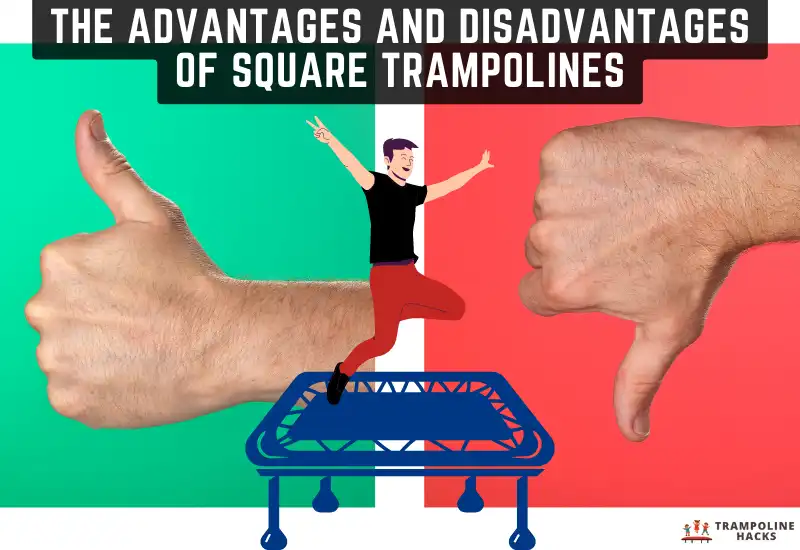
Square trampoline is priced higher than oval trampolines but costs lower than rectangular models. Naturally, it has its fair share of strengths and weaknesses.
Here are the major advantages of square trampolines that you should know about:
- It is smaller and takes up little space in your backyard.
- It offers a decent level of bounciness.
- It can handle one or two kids bouncing on it at the same time
- It costs lower than rectangle trampolines
On the other hand, the weaknesses of a square trampoline are:
- It is still not as cheap as a round trampoline
- It has a lower weight capacity compared to a rectangle trampoline.
- The jumping area is smaller than a rectangle trampoline.
The Advantages and Disadvantages Of Rectangle Trampolines
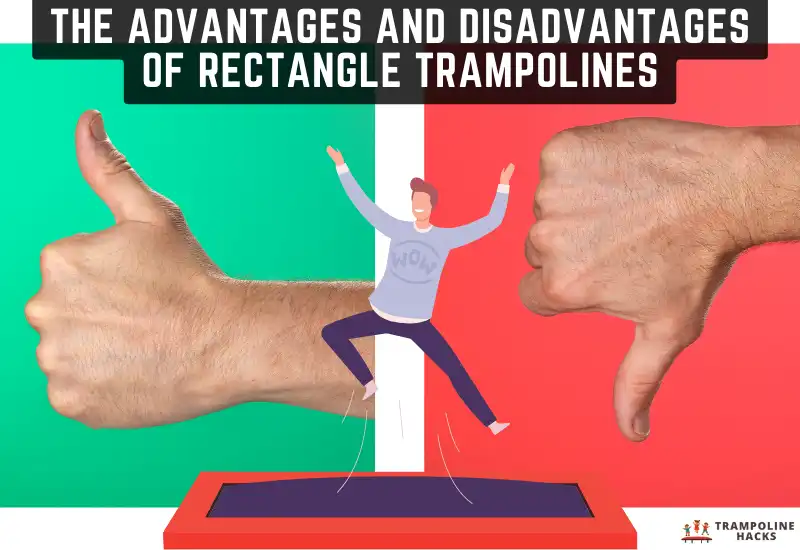
Rectangle trampolines, though they may cost a fortune, offer you a premium bounce for your money. There is a reason why enthusiasts mostly prefer going with a rectangle trampoline over any other shape.
Here are the major advantages of going with a rectangle trampoline:
- It has a larger jumping area.
- It is suitable for gymnasts or people with a large family
- It gives you an excellent bounce regardless of where you land on the jumping mat
- It can handle the most weight out of any other trampoline shapes
However, there are also a couple of drawbacks to a rectangle trampoline:
- It is expensive
- It is not as safe as a round trampoline
- It might not be the best choice for kids
- It is a bit more challenging to set up in a tight backyard
When the Dust Settles
As you can see, there is no clear answer to whether a square trampoline is better than a rectangle trampoline or vice versa. The choice of shape depends mainly on the user and what he is trying to get out of it.
For larger families, going with a big rectangular trampoline might be a great idea. However, it costs a lot more than a square trampoline and takes up a lot of space. And if your backyard cannot support it, there is no point in buying it.
Hopefully, my extensive comparison between square vs. rectangle trampolines helped you do your homework on which shape is better for you and your backyard. Cheers!
Hi, It’s Jason and Louise here and welcome to our website. We are parents to Hannah and Zachary who absolutely love the outdoors and are actually addicted to jumping on their trampoline. Our amazing little family lives on a beautiful 20-hectare rural property with Horses, Dogs, Cats, Chooks, a Rooster, Cats and also a Pet Kangaroo.
